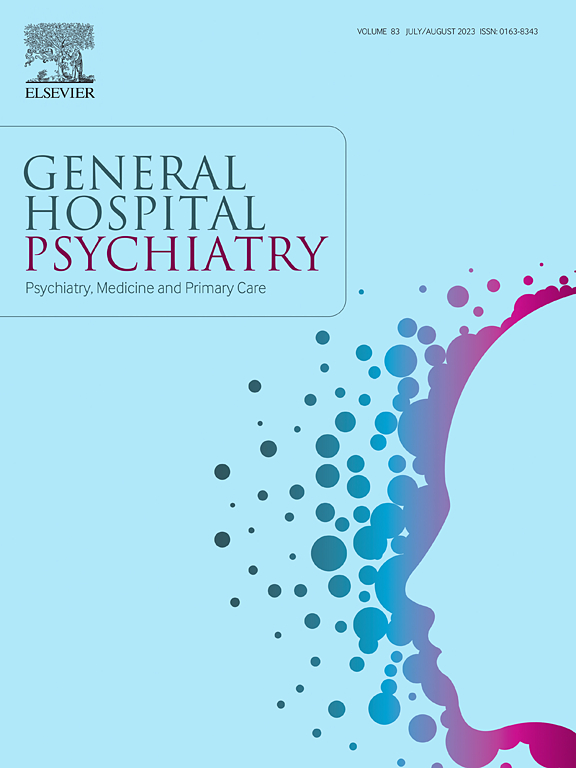重度抑郁障碍中抑郁症状和认知缺陷的性别特异性网络:网络分析方法
IF 3.7
2区 医学
Q1 PSYCHIATRY
引用次数: 0
摘要
重度抑郁症(MDD)是一种以严重的认知和情绪障碍为特征的普遍精神健康状况。新出现的证据表明,这些症状与认知缺陷的相互作用存在性别差异,但机制尚不清楚。传统方法在捕获这些复杂的相互作用方面存在局限性。本研究采用网络分析来调查和对比被诊断为重度抑郁症的男性和女性个体的抑郁症状和认知功能之间的相互关系,为该疾病的性别特异性模式提供了新的见解。方法纳入375例诊断为重度抑郁症的住院患者,其中男性148例,女性227例。临床评估包括24项汉密尔顿抑郁评定量表(HDRS-24)和一系列针对注意力、记忆力、处理速度和执行功能等领域的神经认知评估。采用高斯图形模型(Gaussian graphical models, GGMs)构建抑郁症状和认知功能网络,重点识别这些网络中的中心症状和桥状症状。结果网络分析揭示了男性和女性抑郁症状与认知功能相互作用的不同模式。在男性中,睡眠障碍和加工速度是主要特征,而在女性中,精神运动障碍、工作记忆和加工速度更为突出。男性的主要桥梁症状为睡眠障碍,女性的主要桥梁症状为精神运动障碍和工作记忆障碍。尽管存在这些差异,但在全球网络强度或结构方面没有发现显著的性别差异。结论本研究揭示了男性和女性重度抑郁症患者抑郁症状与认知功能网络关系的不同模式。这些发现表明,尽管重度抑郁症对认知功能的总体影响在性别上是一致的,但这些影响表现出来的途径是不同的。这强调了针对这些性别特异性网络特征的定制治疗策略的必要性,以优化重度抑郁症患者的治疗结果。本文章由计算机程序翻译,如有差异,请以英文原文为准。
Sex-specific networks of depressive symptoms and cognitive deficits in major depressive disorder: A network analysis approach
Background
Major depressive disorder (MDD) represents a prevalent mental health condition characterized by profound cognitive and emotional disturbances. Emerging evidence suggests sex differences in how these symptoms interact with cognitive deficits, yet the mechanisms remain unclear. Traditional methods have limitations in capturing these complex interactions. This research employs network analysis to investigate and contrast the interrelationships between depressive symptoms and cognitive functions in male and female individuals diagnosed with MDD, offering new insights into sex-specific patterns within the disorder.
Methods
A cohort of 375 inpatients diagnosed with MDD, comprising 148 males and 227 females, was recruited for the study. Clinical evaluations encompassed the 24-item Hamilton Depression Rating Scale (HDRS-24) and an extensive array of neurocognitive assessments targeting domains such as attention, memory, processing speed, and executive function. Gaussian graphical models (GGMs) were employed to construct networks of depressive symptoms and cognitive functions, focusing on identifying central and bridge symptoms within these networks.
Results
The network analysis revealed distinct patterns in the interaction of depressive symptoms and cognitive functions between males and females. In males, sleep disturbance and processing speed emerged as central features, while in females, psychomotor retardation, working memory, and processing speed were more prominent. Sleep disturbance was identified as the key bridge symptom in males, whereas psychomotor retardation and working memory served as bridge symptoms in females. Despite these differences, no significant sex differences were found in global network strength or structure.
Conclusion
This study elucidated distinct patterns in the network relationships between depressive symptoms and cognitive functions among male and female patients diagnosed with MDD. These findings suggest that although the overall impact of MDD on cognitive function is consistent across sexes, the pathways through which these effects manifest differ. This underscores the need for tailored therapeutic strategies that target these sex-specific network features to optimize treatment outcomes in MDD patients.
求助全文
通过发布文献求助,成功后即可免费获取论文全文。
去求助
来源期刊

General hospital psychiatry
医学-精神病学
CiteScore
9.60
自引率
2.90%
发文量
125
审稿时长
20 days
期刊介绍:
General Hospital Psychiatry explores the many linkages among psychiatry, medicine, and primary care. In emphasizing a biopsychosocial approach to illness and health, the journal provides a forum for professionals with clinical, academic, and research interests in psychiatry''s role in the mainstream of medicine.
 求助内容:
求助内容: 应助结果提醒方式:
应助结果提醒方式:


